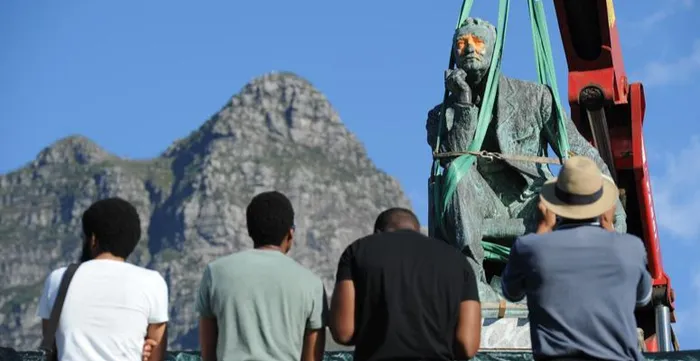A monumental dilemma: why old statues are causing new debates
Brutal reality

The statue of Cecil John Rhodes being prepared for its removal on UCT’s upper campus.
Image: MICHAEL HAMMOND
ACROSS the world, like in South Africa, fierce debates are raging over statues and monuments honouring figures from colonial and apartheid eras. From the toppling of a slave trader’s statue in Bristol, England, to the #RhodesMustFall protests and parliamentary debates in South Africa, communities and politicians are questioning why figures who caused immense suffering are still celebrated in public arenas.
This conflict is not simply about erasing the past, as some suggest. Instead, it is a profound, modern-day reckoning with the painful and persistent legacies of colonialism. To understand the arguments, we must look at the deep-seated ideas that these bronze and stone figures represent.
From gaining independence to undoing a mindset
To grasp the core of the debate, it’s useful to understand two key ideas: decolonisation and decoloniality.
Decolonisation is the historical process most of us learned about in school: it’s when a colony gains political independence from its ruling empire and becomes a new, self-governing country. This was often an incomplete achievement. New nations inherited colonial laws, borders, and educational and economic systems, meaning that the structures of colonial power often remained even after the colonisers themselves had departed.
Decoloniality, on the other hand, is the ongoing struggle to dismantle these structures left behind by colonialism. It’s a deeper project aimed at freeing societies from the colonial mindset - the enduring belief that Western knowledge, culture, and ways of life are superior – white superiority and black inferiority. This lingering system, which scholars call the "colonial matrix of power," continues to fuel global inequality by perpetuating the same racial and economic hierarchies established centuries ago. The fight over statues is a visible expression of this deeper struggle for decoloniality.
The hidden violence of colonialism
The colonial project was not just a military and economic conquest; it was also a systematic assault on the identity and humanity of colonised people. To justify exploitation and land theft, colonisers had to portray indigenous populations as inferior and uncivilised. This was achieved through several interconnected forms of destruction:
- Epistemicide (the killing of knowledge): colonial powers systematically dismissed and destroyed indigenous knowledge systems - from medicine and agriculture to spirituality and philosophy - labelling them as mere superstition. European knowledge was presented as the only rational and true way of knowing, an act of intellectual erasure that provided the moral justification for the "civilising mission."
- Culturecide and linguicide (the killing of culture and language): Colonial authorities deliberately suppressed native cultures and languages. In “residential schools”, for example, indigenous children were brutally punished for speaking their mother tongue. Since language is the lifeblood of culture and a people’s connection to their land, destroying it was a powerful tool for breaking a community’s spirit and social cohesion and entrenching white supremacy.
- Genocide: While we often associate genocide with mass murder, the lawyer who coined the term, Raphael Lemkin, defined it more broadly to include the coordinated destruction of a group's culture, language, and social institutions. In this sense, the cultural and intellectual violence of colonialism was also a form of genocide, designed to annihilate a people by destroying the very foundations of their existence.
Set in stone: what a statue really says
Within this framework, a statue is never just a neutral historical marker. It is a powerful statement of values, actively shaping our public spaces and telling us who deserves to be honoured. Statues of colonial figures do three things:
- Firstly, they glorify oppressors: These monuments celebrate men who were architects of slavery, dispossession, and mass violence, presenting them as noble pioneers or city benefactors while completely erasing the brutal reality of their actions.
- Secondly, they falsify history: Many of these statues are not authentic relics of the past but are political propaganda being ideologically loaded.
- Thirdly, they inflict ongoing harm: For the descendants of those who were enslaved and colonised, these statues are a source of continuous psychological violence.
They are the physical embodiment of a hegemonic historical narrative that sanitises violence, normalises ideologies of racial supremacy, and inflicts ongoing psychological harm on marginalised communities. Their presence in places of honour is a daily reminder of historical trauma and sends a clear message that the society they live in still venerates their ancestors' oppressors.
The arguments for and against removal stem from two fundamentally different views of history. Those who argue for preservation often claim that removing statues is "erasing history" and that they should be kept, perhaps with an added plaque for context. Some also defend them on the grounds of artistic or heritage value.
From a decolonial perspective, these arguments are flawed. Proponents of removal argue that the statues themselves erase and distort history by presenting a sanitised, one-sided lie. Removing them is therefore not an act of censorship, but a correction of the public record. They contend that a small plaque cannot undo the powerful message of glorification sent by a towering monument, and that the "art" in question is, in fact, racist propaganda, a heritage that civilised people should be ashamed of, not proud of. The goal is to end the ongoing harm these symbols cause and to reclaim public space in the name of justice and equality.
The future of memory: it was never just about the statue
The #RhodesMustFall movement, which began in 2015 at the University of Cape Town, is a perfect example of these ideas in action. The protest started with a demand to remove a statue of the imperialist Cecil Rhodes, but it quickly grew into a nationwide movement calling for the complete "decolonisation" of South Africa's education system - from its Eurocentric curriculum to its lack of black professors.
This shows that the fight over a statue is never just about the statue itself. It is a symbolic entry point into a much deeper conversation about the unfinished business of liberation. Toppling a monument is a rejection of a history written by the victors and a demand for a more honest, inclusive, and just public memory. It is the first step in dismantling the invisible structures of colonial thought and building a future that does not continue to celebrate the architects of its own people's oppression.

Professor Dasarath Chetty
Image: File
Professor Dasarath Chetty is a Sociologist and Visiting Professor at Universities in Germany, India and Malaysia.
** The views expressed do not necessarily reflect the views of IOL or Independent Media.
Related Topics: